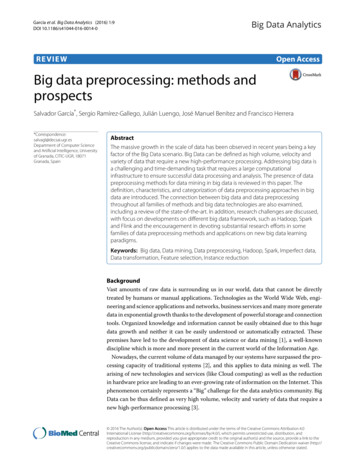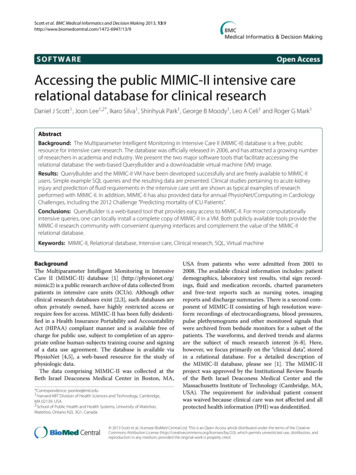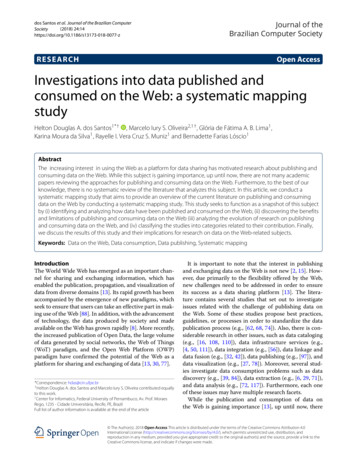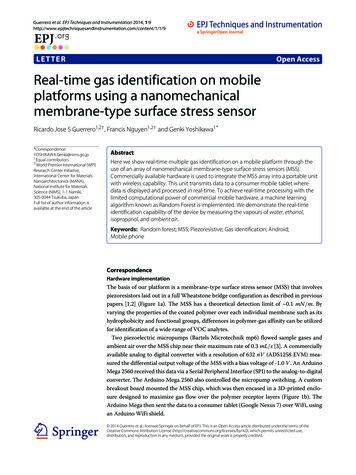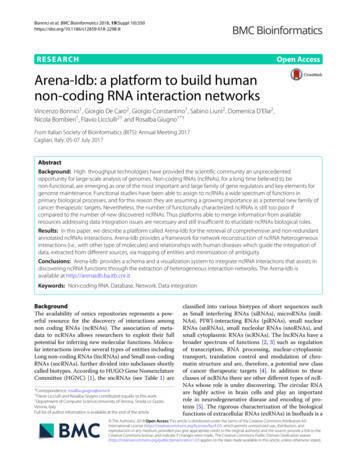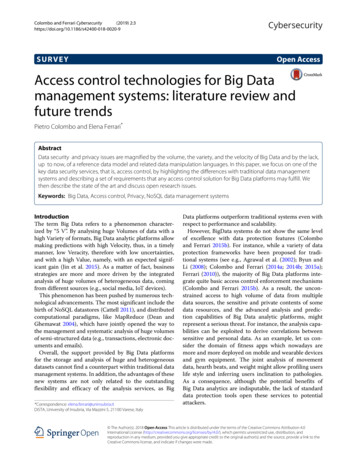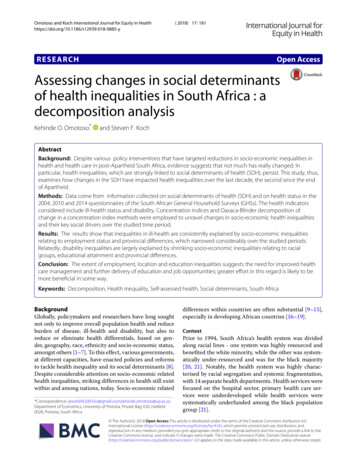
Transcription
García-Gil et al. Big Data Analytics (2017) 2:1DOI 10.1186/s41044-016-0020-2Big Data AnalyticsREVIEWOpen AccessA comparison on scalability for batch bigdata processing on Apache Spark and ApacheFlinkDiego García-Gil1*, Sergio Ramírez-Gallego1 , Salvador García1,2 and Francisco epartment of Computer Scienceand Artificial Intelligence, CITIC-UGR(Research Center on Informationand Communications Technology),University of Granada, CallePeriodista Daniel Saucedo Aranda,18071 Granada, SpainFull list of author information isavailable at the end of the articleAbstractThe large amounts of data have created a need for new frameworks for processing. TheMapReduce model is a framework for processing and generating large-scale datasetswith parallel and distributed algorithms. Apache Spark is a fast and general engine forlarge-scale data processing based on the MapReduce model. The main feature of Sparkis the in-memory computation. Recently a novel framework called Apache Flink hasemerged, focused on distributed stream and batch data processing. In this paper weperform a comparative study on the scalability of these two frameworks using thecorresponding Machine Learning libraries for batch data processing. Additionally weanalyze the performance of the two Machine Learning libraries that Spark currently has,MLlib and ML. For the experiments, the same algorithms and the same dataset arebeing used. Experimental results show that Spark MLlib has better perfomance andoverall lower runtimes than Flink.Keywords: Big data, Spark, Flink, MapReduce, Machine learningIntroductionWith the always growing amount of data, the need for frameworks to store and processthis data is increasing. In 2014 IDC predicted that by 2020, the digital universe will be 10times as big as it was in 2013, totaling an astonishing 44 zettabytes [1]. Big Data is notonly a huge amount of data, but a new paradigm and set of technologies that can storeand process this data. In this context, a set of new frameworks focused on storing andprocessing huge volumes of data have emerged.MapReduce [2] and its open-source version Apache Hadoop [3, 4] were the first distributed programming techniques to face Big Data storing and processing. Since then,several distributed tools have emerged as consequence of the spread of Big Data. ApacheSpark [5, 6] is one of these new frameworks, designed as a fast and general engine forlarge-scale data processing based on in-memory computation. Apache Flink [7] is a noveland recent framework for distributed stream and batch data processing that is getting alot of attention because of its streaming orientation.Most of these frameworks have their own Machine Learning (ML) library for Big Dataprocessing. The first one was Mahout [8] (as part of Apache Hadoop [3]), followed byMLlib [9] which is part of Spark project [5]. Flink also has its own ML library that, while it The Author(s). 2017 Open Access This article is distributed under the terms of the Creative Commons Attribution 4.0International License (http://creativecommons.org/licenses/by/4.0/), which permits unrestricted use, distribution, andreproduction in any medium, provided you give appropriate credit to the original author(s) and the source, provide a link to theCreative Commons license, and indicate if changes were made. The Creative Commons Public Domain Dedication waiver ) applies to the data made available in this article, unless otherwise stated.
García-Gil et al. Big Data Analytics (2017) 2:1Page 2 of 11is not as powerful or complete as Spark’s MLlib, it is starting to include some classic MLalgorithms.In this paper, we present a comparative study between the ML libraries of these twopowerful and promising frameworks, Apache Spark and Apache Flink. Our main goal isto show the differences and similarities in performance between these two frameworksfor batch data processing. For the experiments, we use two algorithms present in bothML libraries, Support Vector Machines (SVM) and Linear Regression (LR), on the samedataset. Additionally, we have implemented a feature selection algorithm to compare thedifferent functioning of each framework.BackgroundIn this section, we describe the MapReduce framework and two extensions of it, ApacheSpark and Apache Flink.MapReduceMapReduce is a framework that has supposed a revolution since Google introduced itin 2003 [2]. This framework processes and generates large datasets in a parallel and distributed way. It is based on the Divide and Conquer algorithm. Briefly explained, theframework splits the input data and distributes it across the cluster, then the same operation is performed on each split in parallel. Finally, the results are aggregated and returnedto the master node. The framework manages all the task scheduling, monitoring andre-executing in case of failed tasks.The MapReduce model is composed of two phases: Map and Reduce. Before the Mapoperation, the master node splits the dataset and distributes it across the computingnodes. Then the Map operation is performed to every key-value pair to the node localdata. This produces a set of intermediate key-value pairs. Once all Map tasks have finished, the results are grouped by key and redistributed so that all pairs belonging to onekey are in the same node. Finally, they are processed in parallel.The Map function takes data structured in key, value pairs as input and outputs aset of intermediate key, value pairs:Map( key1, value1 ) list( key2, value2 )(1)The result is grouped by key and distributed across the cluster. The Reduce phaseapplies a function to each list value, producing a single output value:Reduce( key2, list(value2) ) key2, value3 (2)Apache Hadoop [3, 4] has become the most popular open-source framework for largescale data storing and processing based on the MapReduce model. Despite its popularityand performance, Hadoop presents some important limitations [10]: Intensive disk-usageLow inter-communication capabilityInadequacy for in-memory computationPoor perfomance for online and iterative computing
García-Gil et al. Big Data Analytics (2017) 2:1Apache SparkApache Spark [5, 6] is a framework aimed at performing fast distributed computing onBig Data by using in-memory primitives. This platform allows user programs to load datainto memory and query it repeatedly, making it a well suited tool for online and iterativeprocessing (especially for ML algorithms). It was developed motivated by the limitationsin the MapReduce/Hadoop paradigm [4, 10], which forces to follow a linear dataflow thatmake an intensive disk-usage.Spark is based on distributed data structures called Resilient Distributed Datasets(RDDs) [11]. Operations on RDDs automatically place tasks into partitions, maintaining the locality of persisted data. Beyond this, RDDs are an immutable and versatiletool that let programmers persist intermediate results into memory or disk for reusability purposes, and customize the partitioning to optimize data placement. RDDs arealso fault-tolerant by nature. The lazy operations performed on each RDD are trackedusing a “lineage”, so that each RDD can be reconstructed at any moment in case ofdata loss.In addition to Spark Core, some additional projects have been developed to complement the functionality provided by the core. All these sub-projects (built on top of thecore) are described in the following: Spark SQL: introduces DataFrames, which is a new data structure for structured (andsemi-structured) data. DataFrames offers us the possibility of introducing SQLqueries in the Spark programs. It provides SQL language support, withcommand-line interfaces and ODBC/JDBC controllers. Spark Streaming: allows us to use the Spark’s API in streaming environments byusing mini-batches of data which are quickly processed. This design enables the sameset of batch code (formed by RDD transformations) to be used in streaming analyticswith almost no change. Spark Streaming can work with several data sources likeHDFS, Flume or Kafka. Machine Learning library (MLlib) [12]: is formed by common learning algorithmsand statistic utilities. Among its main functionalities includes: classification,regression, clustering, collaborative filtering, optimization, and dimensionalityreduction. This library has been especially designed to simplify ML pipelines inlarge-scale environments. In the latest versions of Spark, the MLlib library has beendivided into two packages, MLlib, build on top of RDDs, and ML, build on top ofDataFrames for constructing pipelines. Spark GraphX: is the graph processing system in Spark. Thanks to this engine, userscan view, transform and join interchangeably both graphs and collections. It alsoallows expressing the graph computation using the Pregel abstraction [13].Apache FlinkApache Flink [7] is a recent open-source framework for distributed stream and batch dataprocessing. It is focused on working with lots of data with very low data latency and highfault tolerance on distributed systems. Flink’s core feature is its ability to process datastreams in real time.Apache Flink offers a high fault tolerance mechanism to consistently recover the stateof data streaming applications. This mechanism is generating consistent snapshots of thePage 3 of 11
García-Gil et al. Big Data Analytics (2017) 2:1distributed data stream and operator state. In case of failure, the system can fall back tothese snapshots.It also supports both stream and batch data processing with his two main APIs: DataStream and DataSet. These APIs are built on top of the underlying stream processingengine.Apache Flink has four big libraries built on those main APIs: Gelly: is the graph processing system in Flink. It contains methods and utilities forthe development of graph analysis applications. FlinkML: this library aims to provide a set of scalable ML algorithms and an intuitiveAPI. It contains algorithms for supervised learning, unsupervised learning, datapreprocessing, recommendation and other utilities. Table API and SQL: is a SQL-like expression language for relational stream and batchprocessing that can be embedded in Flink’s data APIs. FlinkCEP: is the complex event processing library. It allows to detect complex eventspatterns in streams.Although Flink is a new platform, it is constantly evolving with new additions and it hasalready been adopted as a real-time process framework in many big companies, such as:ResearchData, Bouygues Telecom, Zalando and Otto Group.Spark vs. Flink: main differences and similaritiesIn this section, we present the main differences and similarities in the engines of bothplatforms in order to explain which are the best scenarios for one platform or the other.Afterwards, we highlight the main differences between three ML algorithms implementedin both platforms: Distributed Information Theoretic Feature Selection (DITFS), SVMand LR.Comparison between enginesThe first remarkable difference between both engines lies in the way each tool ingestsstreams of data. Whereas Flink is a native streaming processing framework that can workon batch data, Spark was originally designed to work with static data through its RDDs.Spark uses micro-batching to deal with streams. This technique divides incoming dataand processess small parts one at a time. The main advantage of this scheme is that thestructure chosen by Spark, called DStream, is a simple queue of RDDs. This approachallows users to switch between streaming and batch as both have the same API. However,micro-batching may not perform quick enough in systems that requires very low latency.Nevertheless, Flink fits perfectly well in those systems as it natively uses streams for alltype of workloads.Unlike Hadoop MapReduce, Spark and Flink have support for data re-utilization anditerations. Spark keeps data in memory across iterations through an explicit caching.However, Spark plans its executions as acyclic graph plans, which implies that it needs toschedule and run the same set of instructions in each iteration. In contrast, Flink implements a thoroughly iterative processing in its engine based on cyclic data flows (oneiteration, one schedule). Additionally, it offers delta iterations to leverage operations thatonly changes part of data.Page 4 of 11
García-Gil et al. Big Data Analytics (2017) 2:1Page 5 of 11Till the advent of Tungsten optimization project, Spark mainly used the JVM’s heapmemory to manage all its memory [14]. Although it is straightforward solution, it maysuffers from overflow memory problems and garbage collect pauses. Thanks to this novelproject, these problems started to disappear. Through DataFrames, Spark is now able toto manage its own memory stack and to exploit the memory hierarchy available in modern computers (L1 and L2 CPU caches). Flink’s designers, however, had these facts intoconsideration from the initial point [15]. The Flink team thus proposed to maintain a selfcontrolled memory stack, with its own type extraction and serialization strategy in binaryformat. The advantage derived from these tunes are: less memory errors, less garbagecollection pressure, and a better space data representation, among others.About optimization, both frameworks have mechanisms that analyze the code submitted by the user and yields the best pipeline code for a given execution graph. Sparkthrough the DataFrames API and Flink as first citizen. For instance, in Flink a join operation can be planned as a complete shuffling of two sets, or as a broadcast of the smallestone. Spark also offers a manual optimization, which allows the user to control partitioningand memory caching.The rest of matters about easiness of coding and tuning, variety of operators, etc. havebeen omitted from this comparison as these factors do not affect the performance ofexecutions.A thorough comparison between algorithm implementationsHere, we present the implementation details of three ML algorithms implemented inSpark and Flink. Firstly, a feature selection algorithm implemented by us in both platformsis reviewed. Secondly, the native implementation of SVM in both platforms is analyzed.And lastly, the same process is applied for the native implementation of LR.Distributed information theoretic feature selectionFor comparison purposes, we have implemented in both platforms a feature selection framework based on information theory. This framework was proposed by Brownet al. [16] in order to ensemble multiple information theoretic criteria into a single greedyalgorithm. Through some independence assumptions, it allows to transform many criteriaas linear combinations of Shannon entropy terms: mutual information (MI) and conditional mutual information (CMI). Some relevant algorithms like minimum RedundancyMaximum Relevance or Information Gain, among others, are included in the framework.The main objective of the algorithm is to assess features based on a simple score, and toselect those more relevant according to a ranking. The generic framework proposed byBrown et al. [16] to score features can be formulated as:J I(Xi ; Y ) β I Xj ; Xi γI Xj ; Xi Y ,Xj S(3)Xj Swhere the first term represents the relevance (MI) between the candidate input features Xiand the class Y, the second one the redundancy (MI) between the features already selected(in the set S) and the candidate ones, and the third one the conditional redundancy (CMI)between both sets and the class. γ represents a weight factor for CMI and β the samefor MI.
García-Gil et al. Big Data Analytics (2017) 2:1Page 6 of 11Brown’s version was re-designed for a better performance in distributed environments.The main changes accomplished by us are described below: Column-wise transformation: most of feature selection methods performscomputations by columns. It implies that a previous transformation of data to acolumnar format may improve the performance of further computations, forexample, when computing relevance or redundancy. Accordingly, the first step in ourprogram is aimed at transforming the original set into columns where each newinstance contains the values for each feature and partition in the original set. Persistence of important information: some pre-computed data like the transformedinput or the initial relevances are cached in memory in order to avoid re-computingthem in next phases. As this information is computed once at the start, itspersistence can speed up significantly the performance of the algorithm. Broadcast of variables: in order to avoid moving transformed data in each iteration,we persist this set and only broadcast those columns (feature) involved in the currentiteration. For example, in the first iteration the class feature is broadcasted tocompute the initial relevance values in each partition.In the Flink implementation a bulk iteration process has been used to copewith the greedy process. In the Spark version, the typical iterative process withcaching and repeated tasks has been implemented. Flink code can be found in thefollowing GitHub repository: atureselection. The Spark code was gathered into a package and uploaded to theSpark’s third-party package repository: infotheoretic-feature-selection.Linear support vector machinesBoth Spark and Flink implements SVMs classifiers using a linear optimizer. Briefly, theminimization problem to be solved is the following:1 T λ w 2 li w xi2nnminw Rd(4)i 1where w is the weight vector, xi Rd the data instances, λ the regularization constant,and li the convex loss functions. For both versions, the default regularizer is l2 -norm and the loss function is the hinge-loss: li max 0, 1 yi wT xiThe Communication-efficient distributed dual Coordinate Ascent algorithm (CoCoA)[17] and the stochastic dual coordinate ascent (SDCA) algorithms are used in Flink tosolve the previously defined minimization problem. CoCoA consists of several iterationsof SDCA on each partition, and a final phase of aggregation of partial results. The resultis a final gradient state, which is replicated across all nodes and used in further steps.In Spark a distributed Stochastic Gradient Descent1 (SGD) solution is adopted [12]. InSGD a sample of data (called mini batches) are used to compute subgradients in eachphase. Only the partial results from each worker are sent across the network in order toupdate the global gradient.
García-Gil et al. Big Data Analytics (2017) 2:1Page 7 of 11Linear regressionLinear least squares is another simple linear method implemented in Spark. Despite itwas designed for regression, its output can be adapted for binary classification problems.Linear least squares follows the same minimization formula described for SVMs (seeEq. 4) and the same optimization method (based on SGD), however, it uses squared loss 2(described below) and no regularization method: li 12 wT xi yiThe Flink version for this algorithm is quite similar to the one created by Spark’sdevelopers. It uses SGD to approximate the gradient solutions. However, Flink onlyoffers squared loss whereas Spark offers many alternatives, like hinge or logisticloss.Experimental resultsThis section describes the experiments carried out to show the performance of Sparkand Flink using three ML algorithms over the same huge dataset. We carried out thecomparative study using SVM, LR and DITFS algorithm.The dataset used for the experiments is the ECBDL14 dataset. This dataset was used atthe ML competition of the Evolutionary Computation for Big Data and Big Learning heldon July 14, 2014, under the international conference GECCO-2014. It consists of 631 characteristics (including both numerical and categorical attributes) and 32 million instances.It is a binary classification problem where the class distribution is highly imbalanced:2 % of positive instances. For this problem, two pre-processing algorithms were applied.First, the Random OverSampling (ROS) algorithm used in [18] was applied in orderto replicate the minority class instances from the original dataset until the number ofinstances for both classes was equalized, summing a total of 65 millions instances. Finally,for DITFS algorithm, the dataset has been discretized using the Minimum DescriptionLength Principle (MDLP) discretizer [19].The original dataset has been sampled randomly using five differents rates in orderto measure the scalability performance of both frameworks: 10, 30, 50, 75 and 100 % ofthe pre-processed dataset is used. Due to a current Flink limitation, we have employed asubset of 150 features of each ECBDL14 dataset sample for the SVM learning algorithm.Table 1 gives a brief summary of these datasets. For each one, the number of examples(Instances), the total number of features (Feats.), the total number of values (Total), andthe number of classes (CL) are shown.We have established 100 iterations, a step size of 0.01 and a regularization parameter of0.01 for the SVM. For the LR, 100 iterations and a step size of 0.00001 are used. Finally,for DITFS 10 features are selected using minimum Redundancy Maximum Relevancealgorithm [20].Table 1 Summary description for ECBDL14 datasetDatasetInstancesFeats.TotalCLECBDL14-106 500 3916314 101 746 7212ECBDL14-3019 501 17463112 305 240 7942ECBDL14-5032 501 95763120 508 734 8672ECBDL14-7548 752 93563130 763 101 9852ECBDL14-10065 003 91363141 017 469 1032
García-Gil et al. Big Data Analytics (2017) 2:1Page 8 of 11Table 2 SVM learning time in secondsDatasetSpark -100174783609As an evaluation criteria, we have employed the overall learning runtime (in seconds)for SVM and Linear Regression, as well as the overall runtime for DITFS.For all experiments we have used a cluster composed of 9 computing nodes andone master node. The computing nodes hold the following characteristics: 2 processors x Intel Xeon CPU E5-2630 v3, 8 cores per processor, 2.40 GHz, 20 MB cache,2 x 2TB HDD, 128 GB RAM. Regarding the software, we have used the followingconfiguration: Hadoop 2.6.0-cdh5.5.1 from Cloudera’s open-source Apache Hadoop distribution, Apache Spark and MLlib 1.6.0, 279 cores (31 cores/node), 900 GB RAM (100GB/node) and Apache Flink 1.0.3, 270 TaskManagers (30 TaskManagers/core), 100 GBRAM/node.Table 2 shows the learning runtime values obtained by SVM with 100 iterations, usingthe reduced version of the datasets with 150 features. Currently SVM is not presentin the Spark ML library, so we omit that experiment. As we can see, Spark scalesmuch better than Flink. The time difference between Spark and Flink increases withthe size of the dataset, being 2.5x slower at the beginning, and 4.5x with the completedataset.Table 3 compares the learning runtime values obtained by LR with 100 iterations.The time difference between Spark MLlib and Spark ML can be explained by internallytransforming the dataset from DataFrame to RDD in order to use the same implementation of the algorithm present in MLlib. Spark ML is around 8x times fasterthan Flink. Spark MLlib version have shown to perform specially better compared toFlink.Table 4 compares the runtime values obtained by DITFS algorithm selecting thetop 10 features of the discretized datset. As stated previously, the differences betweenSpark MLlib and Spark ML can be explained with the internal transformation betweenDataFrame and RDD. We observe that Flink is around 10x times slower than Spark for 10,30 and 50 % of the dataset, 8x times slower for 75 %, and 4x times slower for the completedataset.In Fig. 1 we can see the scalability of the three algorithms compared side to side.Table 3 LR learning time in secondsDatasetSpark MLlibSpark 1731314ECBDL14-7582601878ECBDL14-100124152566
García-Gil et al. Big Data Analytics (2017) 2:1Page 9 of 11Table 4 DITFS runtime in secondsDatasetSpark MLlibSpark 1596615ConclusionsIn this paper, we have performed a comparative study for batch data processing of the scalability of two popular frameworks for processing and storing Big Data, Apache Spark andApache Flink. We have tested these two frameworks using SVM and LR as learning algorithms, present in their respective ML libraries. We have also implemented and tested afeature selection algorithm in both platforms. Apache Spark have shown to be the framework with better scalability and overall faster runtimes. Although the differences betweenSpark’s MLlib and Spark ML are minimal, MLlib performs slightly better than Spark ML.These differences can be explained with the internal transformations from DataFrame toRDD in order to use the same implementations of the algorithms present in MLlib.Flink is a novel framework while Spark is becoming the reference tool in the Big Dataenvironment. Spark has had several improvements in performance over the differentreleases, while Flink has just hit its first stable version. Although some of the Apache Sparkimprovements are already present by design in Apache Flink, Spark is much refined thanFlink as we can see in the results.Apache Flink has a great potential and a long way still to go. With the necessaryimprovements, it can become a reference tool for distributed data streaming analytics. It is pending a study on data streaming, the theoretical strengh of ApacheFlink.7000600050004000300020001000010% 30% 50% 75% 100%10% 30% 50% 75% 100%SVM - 150 feat.Linear RegressionMLlibMLFig. 1 Scalability of SVM, LR and DITFS algorithm in secondsFlinkML10% 30% 50% 75% 100%DITFS
García-Gil et al. Big Data Analytics (2017) c gradient descent.AcknowledgementsNot applicable.FundingThis work is supported by the Spanish National Research Project TIN2014-57251-P, and the Andalusian Research PlanP11-TIC-7765. S. Ramirez-Gallego holds a FPU scholarship from the Spanish Ministry of Education and Science(FPU13/00047).Availability of data and materialsECBDL14 dataset is freely available in [21].Authors’ contributionsDG and SR carried out the comparative study and drafted the manuscript. SG and FH conceived of the study, participatedin its design and coordination and helped to draft the manuscript. All authors read and approved the final manuscript.Competing interestsThe authors declare that they have no competing interests.Consent for publicationNot applicable.Ethics approval and consent to participateNot applicable.Author details1 Department of Computer Science and Artificial Intelligence, CITIC-UGR (Research Center on Information andCommunications Technology), University of Granada, Calle Periodista Daniel Saucedo Aranda, 18071 Granada, Spain.2 Faculty of Computing and Information Technology, King Abdulaziz University, North Jeddah, Saudi Arabia.Received: 13 August 2016 Accepted: 21 October 2016References1. IDC. The Digital Universe of Opportunities. 014.htm. Accessed14 July 2016.2. Dean J, Ghemawat S. Mapreduce: Simplified data processing on large clusters. In: Proceedings of the 6thConference on Symposium on Opearting Systems Design & Implementation - Volume 6. OSDI’04. Berkeley: USENIXAssociation; 2004. p. 10–10.3. Apache Hadoop Project. Apache Hadoop. http://hadoop.apache.org. Accessed 14 July 2016.4. White T. Hadoop: The Definitive Guide. Sebastopol: O’Reilly Media, Inc; 2012.5. Hamstra M, Karau H, Zaharia M, Konwinski A, Wendell P. Learning Spark: lightning-fast big data analytics.Sebastopol: O’Reilly Media; 2015.6. Spark A. Apache Spark: lightning-fast cluster computing. http://spark.apache.org. Accessed 14 July 2016.7. Flink A. Apache Flink. http://flink.apache.org. Accessed 14 July 2016.8. Apache Mahout Project. Apache Mahout. http://mahout.apache.org. Accessed 14 July 2016.9. MLlib. Machine Learning Library (MLlib) for Spark. ml. Accessed14 July 2016.10. Lin JJ. Mapreduce is good enough? if all you have is a hammer, throw away everything that’s not a nail! Big Data.2012;1(1):28–37.11. Zaharia M, Chowdhury M, Das T, Dave A, Ma J, McCauley M, Franklin MJ, Shenker S, Stoica I. Resilient distributeddatasets: A fault-tolerant abstraction for in-memory cluster computing. In: Proceedings of the 9th USENIXConference on Networked Systems Design and Implementation. NSDI’12. Berkeley: USENIX Association; 2012. p. 2–2.12. Meng X, Bradley J, Yavuz B, Sparks E, Venkataraman S, Liu D, Freeman J, Tsai D, Amde M, Owen S, Xin D, Xin R,Franklin MJ, Zadeh R, Zaharia M, Talwalkar A. Mllib: Machine learning in apache spark. J Mach Learn Res.2016;17(34):1–7.13. Malewicz G, Austern MH, Bik AJC, Dehnert JC, Horn I, Leiser N, Czajkowski G. Pregel: A system for large-scalegraph processing. In: Proceedings of the 2010 ACM SIGMOD International Conference on Management of Data.SIGMOD ’10. New York: ACM; 2010. p. 135–46. doi:10.1145/1807167.1807184.14. Apache Spark Project. Project Tungsten (Apache Spark). gstenbringing-spark-closer-to-bare-metal.html Accessed 14 July 2016.15. Apache Flink Project. Peeking Into Apache Flink’s Engine Room. to-Apache-Flinks-Engine-Room.html. Accessed 14 July 2016.16. Brown G, Pocock A, Zhao MJ, Luján M. Conditional likelihood maximisation: A unifying framework for informationtheoretic feature selection. J Mach Learn Res. 2012;13:27–66.Page 10 of 11
García-Gil et al. Big Data Analytics (2017) 2:1Page 11 of 1117. Jaggi M, Smith V, Takác M, Terhorst J, Krishnan S, Hofmann T, Jordan MI. Communication-efficient distributeddual coordinate ascent. CoRR. 2014:3068–76. abs/1409.1458.18. del Río S,
in the Spark ML library, so we omit that experiment. As we can see, Spark scales much better than Flink. The time difference between Spark and Flink increases with and4.5xwiththecomplete dataset. Table 3 compares the learning runtime values obtained by LR with 100 iterations.
